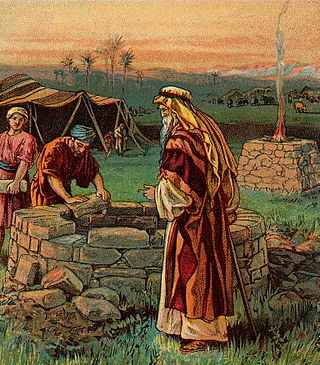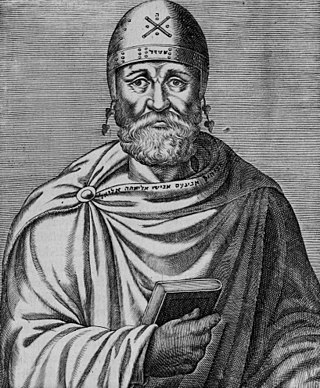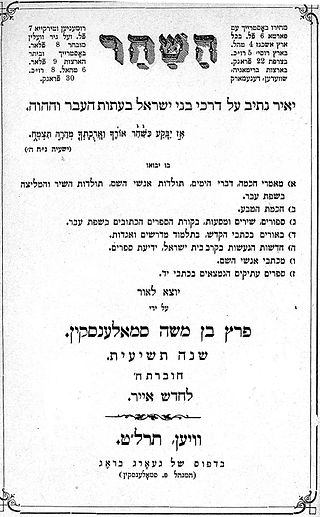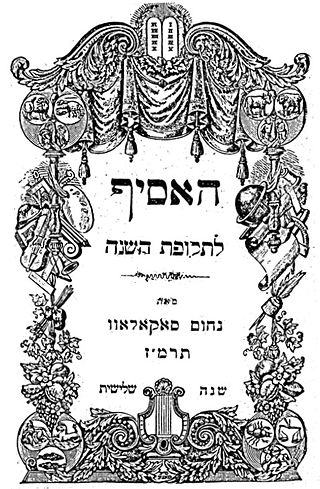Related Research Articles
The Essenes were a mystic Jewish sect during the Second Temple period that flourished from the 2nd century BCE to the 1st century CE.

Isaac is one of the three patriarchs of the Israelites and an important figure in the Abrahamic religions, including Judaism, Christianity, and Islam. He was the son of Abraham and Sarah, the father of Jacob and Esau, and the grandfather of the twelve tribes of Israel.

The Book of Jubilees, sometimes called Lesser Genesis (Leptogenesis), is an ancient Jewish religious work of 50 chapters, considered canonical by the Ethiopian Orthodox Church as well as Beta Israel, where it is known as the Book of Division. Jubilees is considered one of the pseudepigrapha by Roman Catholic, Eastern Orthodox, and Protestant Churches. It is also not considered canonical within Judaism outside of Beta Israel.
The Sadducees were a socio-religious sect of Jews active in Judea during the Second Temple period, from the second century BCE to the destruction of the Second Temple in 70 CE. The Sadducees are often compared to other contemporaneous sects, including the Pharisees and the Essenes.

Philo of Alexandria, also called Philo Judaeus, was a Hellenistic Jewish philosopher who lived in Alexandria, in the Roman province of Egypt.
Karaite Judaism or Karaism is a Jewish religious movement characterized by the recognition of the written Tanakh alone as its supreme authority in halakha and theology. Karaites believe that all of the divine commandments which were handed down to Moses by God were recorded in the written Torah without any additional Oral Law or explanation. Unlike mainstream Rabbinic Judaism, which regards the Oral Torah, codified in the Talmud and subsequent works, as authoritative interpretations of the Torah, Karaite Jews do not treat the written collections of the oral tradition in the Midrash or the Talmud as binding.
Daniel al-Kumisi was one of the most prominent early scholars of Karaite Judaism. He flourished at the end of the ninth or at the beginning of the tenth century. He was a native of Damagan, the capital of the province of Qumis, in the former state of Tabaristan,, as is shown by his two surnames, the latter of which is found only in Qirqisani. His attitude to Anan ben David and his violent opposition to the Ananites are characteristic of his place in Karaism. At first he esteemed Anan highly, calling him rosh hamaskilim ; but later he despised him and called him rosh ha-kesilim. Nevertheless, Daniel's opinions were respected by the Karaites.
Benjamin Nahawandi or Benjamin ben Moses Nahawendi was a prominent Persian Jewish scholar of Karaite Judaism. He was claimed to be one of the greatest of the Karaite scholars of the early Middle Ages. The Karaite historian Solomon ben Jeroham regarded him as greater even than Anan ben David. His name indicates that he is originally from Nahawand, a town in Iran (Persia).
Showbread, in the King James Version: shewbread, in a biblical or Jewish context, refers to the cakes or loaves of bread which were always present, on a specially-dedicated table, in the Temple in Jerusalem as an offering to God. An alternative, and more appropriate, translation would be presence bread, since the Bible requires that the bread be constantly in the presence of God.

In Judaism, Christianity and Islam, the Book of Life is the book in which God records, or will record, the names of every person who is destined for Heaven and the world to come. According to the Talmud, it is opened on Rosh Hashanah, the Jewish New Year, as is its analog for the wicked, the Book of the Dead. For this reason, extra mention is made for the Book of Life during amidah recitations during the High Holy Days, the ten days between Rosh Hashanah and Yom Kippur, the day of atonement.
Joseph ben Abraham was a Karaite philosopher and theologian who flourished in Babylonia or Persia in the first half of the eleventh century. He was the teacher of, among others, Jeshua ben Judah. By way of euphemism he was surnamed "ha-Ro'eh", on account of his blindness. This infirmity, however, did not prevent him from undertaking long journeys, likely as a Karaite missionary. In the course of his travels he frequented the religio-philosophical schools of the Mu'tazili, whose teachings he defended in his works. Of these the most important is the Muhtawi, translated from the Arabic into Hebrew, perhaps by Tobiah ben Moses, under the title Sefer ha-Ne'imot, or Zikron ha-Datot. It is divided into forty chapters, in which all the main principles of the Mu'tazili kalam are applied to the Karaite dogmas: the five principles of the unity of God; the necessity of admitting atoms and accidents; the existence of a Creator; the necessity of admitting certain attributes and rejecting others; God's justice and its relation to free will; reward and punishment; etc. The author often argues against the Christians, the Dualists, the Magians, the Epicureans, and various other sects, with whose tenets he shows himself well acquainted. He cites the founders of the Mu'tazili sects of al-Jabaiyah and al-Bahshamiyyah, Abu Ali Muhammad ibn Abd al-Wahhab al-Jabai, and his son Hashim Abd al-Salam, whose teachings he closely follows. The Muhtawi is still extant in manuscript, both in the Arabic original and in its Hebrew translation; the former in the David Kaufmann Library, the latter in the libraries of Leiden, Paris, and St. Petersburg.
Jacob Qirqisani was a Karaite dogmatist and exegete who flourished in the first half of the tenth century. His origins are unknown. His patronym "Isaac" and teknonym "Joseph" reflect no more than the genealogy of the biblical patriarchs, while his surname has been taken as referring to either ancient Circesium in eastern Syria, or Karkasān, near Baghdad, though no Karaite community is known in either place. He seems to have traveled throughout the Middle East, visiting the centers of Islamic learning, in which he was well-versed.

A burnt offering in Judaism is a form of sacrifice first described in the Hebrew Bible. As a tribute to God, a burnt offering was entirely burnt on the altar. This is in contrast to other forms of sacrifice, which was partly burnt and most of it eaten in communion at a sacrificial meal.
Ḥiwi al-Balkhi was an exegete and Biblical critic of the last quarter of the ninth century born in Balkh, Khorasan. It is not entirely clear whether Hiwi was a Jew, as suggested by Schechter (1901), or whether he was perhaps a member of a gnostic Christian sect. Some claim that he was a member of the ancient Bukharan Jewish community of Central Asia.

David ibn Merwan al-Mukkamas al-Rakki was a philosopher and controversialist, the author of the earliest known Jewish philosophical work of the Middle Ages. He was a native of Raqqa, Mesopotamia, whence his surname. Harkavy derives his byname from the Arabic "ḳammaṣ", interpreting it as referring to his asserted change of faith. This is uncertain. The name is written "אלקומסי" in Masudi's Al-Tanbih, in a Karaitic commentary to Leviticus, and in a manuscript copy of Jefeth's commentary to the same book, and is perhaps a derivative from the city of Ḳumis in Taberistan. Another Karaite bears the name "Daniel al-Ḳumisi," and in Al-Hiti's chronicle this name is also spelled with a ẓade.
Proto-Gnosticism or pre-Gnosticism refers to movements similar to Gnosticism in the first few centuries of Christianity. Proto-Gnostics did not have the same full fledged theology of the later Gnostics but prefigured some of their views. There is however some debate regarding the existence of proto-Gnosticism in the first century.

Ha-Shaḥar was a Hebrew-language monthly periodical, published and edited at Vienna by Peretz Smolenskin from 1868 to 1884.

Ha-Asif was a Hebrew-language yearly journal, published in Warsaw by Naḥum Sokolow.
The Yudghanites ("Al-Yudghaniyyah") were a Jewish sect named after its founder, Yudghan or Judah of Hamadan, a disciple of Abu Isa al-Isfahani.
Maghāriya were a minor Jewish sect that appeared in the first century BC, their special practice was the keeping of all their literature in caves in the surrounding hills in Palestine. The Maghāriya believed that God is too sublime to mingle with matter, thus they did not believe that God directly created the world, but that an angel, which represents God created the earth. They made their own commentaries on the Bible and the law. Some scholars have identified the Maghāriya as part of the Essenes or the Therapeutae.
References
![]() This article incorporates text from a publication now in the public domain : Singer, Isidore; Broydé, Isaac (1904). "Maghariyyah, Al-". In Singer, Isidore; et al. (eds.). The Jewish Encyclopedia . Vol. 8. New York: Funk & Wagnalls. p. 254–255.
This article incorporates text from a publication now in the public domain : Singer, Isidore; Broydé, Isaac (1904). "Maghariyyah, Al-". In Singer, Isidore; et al. (eds.). The Jewish Encyclopedia . Vol. 8. New York: Funk & Wagnalls. p. 254–255.
- 1 2 Schiffman, Lawrence H.; VanderKam, James C., eds. (2000). "Magharians". Encyclopedia of the Dead Sea Scrolls. Oxford University Press. ISBN 978-0-19-508450-4.
- ↑ Harkavy, Abraham. "Le-Ḳorot ha-Kittot be-Yisrael". In Grätz, Heinrich (ed.). Geschichte der Juden (in Hebrew). Vol. iii. p. 496.